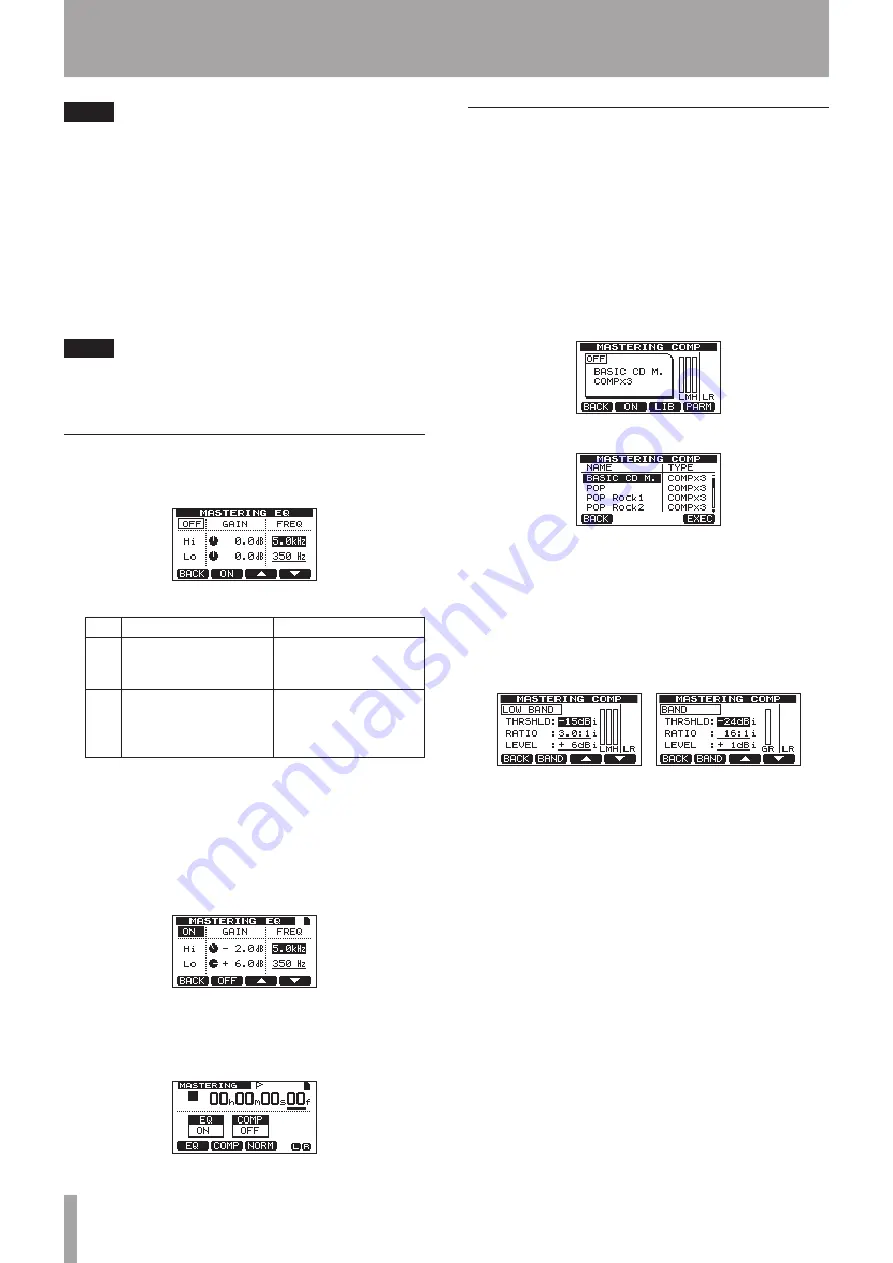
52
TASCAM DP-03SD
9 – Mixing down and mastering tracks
NOTE
If you stop recording in the middle, a stereo master track will
be created until the time when you stopped the unit.
Step 4. Check the mastered recording.
Turn the equalizer and compressor OFF before playing back the
mastered stereo track to check the results of mastering. Undo
and redo can be used, so you can compare the sound before and
after mastering.
If you are not satisfied with the result:
Undo the recording to restore the stereo master track to the
state before being overwritten and repeat the mastering
procedures above from Step 1.
NOTE
Undo and redo cannot be used when the unit is in
MASTERING mode. Switch to MULTITRACK or MIXDOWN
mode to use these functions.
Using mastering EQ (equalizer)
1 When the
MASTERING
screen is open, press the F1 (
EQ
)
button to open the
MASTERING EQ
screen.
2 Set the mastering equalizer using the following parameters.
GAIN
FREQ
Hi
High-frequency gain
Setting range: ±12 dB
(Default value: 0.0 dB)
High-frequency value
Setting range: 1.7–18 kHz
(Default value: 5 kHz)
Lo
Low-frequency gain
Setting range: ±12 dB
(Default value: 0.0 dB)
Low-frequency value
Setting range: 32 Hz–1.6
kHz
(Default value: 350 Hz)
Use the EQ HIGH knob to adjust the
Hi
gain and the EQ
LOW knob to adjust the
Lo
gain.
Use the F3 (
§
) and F4 (
¶
) buttons to select Hi or Lo, and
use the DATA wheel to set the
FREQ
value.
Whether the mastering equalizer is
ON
or
OFF
is shown in
the upper left of the display. When
OFF
, press the F2 (
ON
)
button to turn EQ ON, and when
ON
press the F2 (
OFF
)
button to turn EQ OFF.
3 After making the setting, press the F1 (
BACK
) button to
return to the Home Screen.
The
EQ
item on the
MASTERING
screen shows whether
the mastering equalizer is currently ON or OFF.
Using mastering compression
You can select either a single band or multi-band type of
mastering compressor from the library.
Multi-band compressors divide the stereo master track into
low, mid and high frequency ranges that can be processed
using independent settings, allowing adjustment of the overall
volume balance.
By using compression, you can reduce unwanted peaks and
increase the overall gain in order to raise the volume, creating a
mastered sound with greater impact.
1 When the
MASTERING
screen is open, press the F2
(
COMP
) button to open the
MASTERING COMP
screen.
2 Press the F3 (
LIB
) button to open the library screen.
3 Use the DATA wheel to select an item in the library, and
press the F4 (
EXEC
) button to confirm the selection.
Items with the
TYPE
of
COMPX3
are multi-band, while
COMPX1
items are single band compressors.
After the item loads from the library, the
MASTERING
COMP
screen reopens.
4 Next, press the F4 (
PARM
) button to open the parameter
setting screen.
At this time, the selected band is shown in the upper left. If it
is a multi-band compressor, press the F2 (
BAND
) button to
change the band that you are adjusting. Each time you press
this button, the band cycles through
LOW
,
MID
and
HIGH
band. For single band types, F2 switches between
BAND
and “
A.MAKEUP
.
5 Use the F3 (
§
) and F4 (
¶
) buttons to select the value of the
item that you want to set, and use the DATA wheel to set it.
When a setting is at its default value, an “
i
” appears next to
it.
The setting items and their ranges are as follows.
THRSHLD
: Set the threshold value that determines when
the compressor begins to operate. (Range: –32 dB to 0 dB in
1 dB steps)
RATIO
: Set the compression ratio. (1.0: 1, 1.1: 1, 1.3: 1, 1.5: 1,
1.7: 1, 2.0: 1, 2.5: 1, 3.0: 1, 3.5: 1, 4.0: 1, 5.0: 1, 6.0: 1, 8.0: 1, 16.0:
1, inf: 1)
LEVEL
: Set the output level. (Range: -20 dB to +20 dB in 1
dB steps)
6 When using a multi-band compressor, press the F2 (
BAND
)
button to open the next band. Make settings as necessary
for all brands.






























